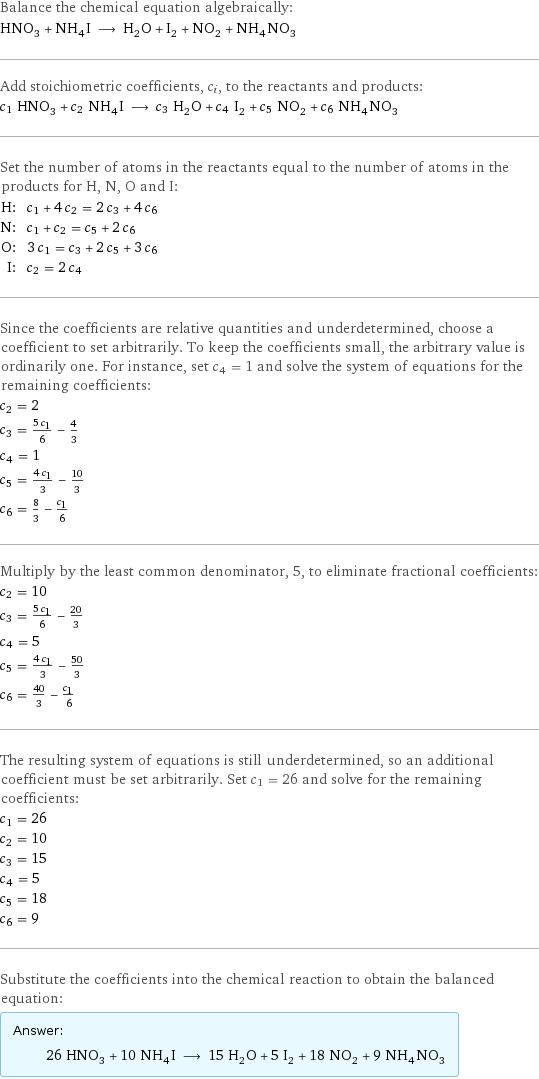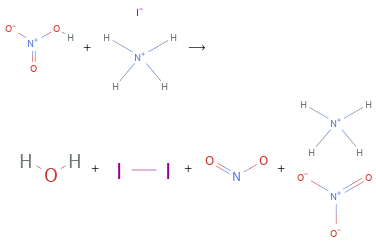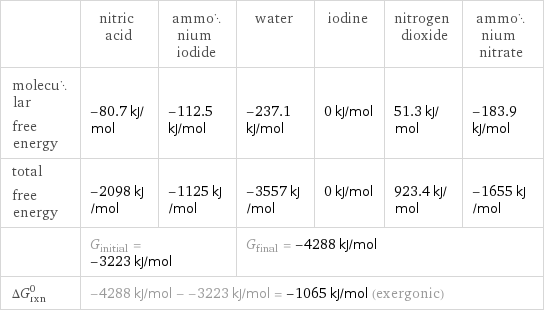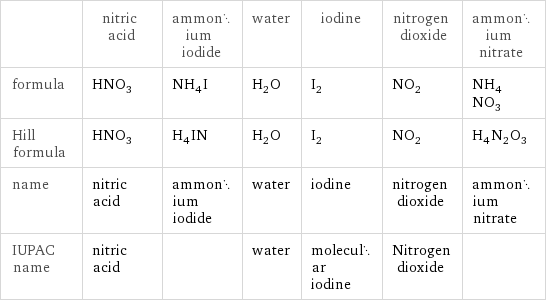Input interpretation

HNO_3 nitric acid + NH_4I ammonium iodide ⟶ H_2O water + I_2 iodine + NO_2 nitrogen dioxide + NH_4NO_3 ammonium nitrate
Balanced equation

Balance the chemical equation algebraically: HNO_3 + NH_4I ⟶ H_2O + I_2 + NO_2 + NH_4NO_3 Add stoichiometric coefficients, c_i, to the reactants and products: c_1 HNO_3 + c_2 NH_4I ⟶ c_3 H_2O + c_4 I_2 + c_5 NO_2 + c_6 NH_4NO_3 Set the number of atoms in the reactants equal to the number of atoms in the products for H, N, O and I: H: | c_1 + 4 c_2 = 2 c_3 + 4 c_6 N: | c_1 + c_2 = c_5 + 2 c_6 O: | 3 c_1 = c_3 + 2 c_5 + 3 c_6 I: | c_2 = 2 c_4 Since the coefficients are relative quantities and underdetermined, choose a coefficient to set arbitrarily. To keep the coefficients small, the arbitrary value is ordinarily one. For instance, set c_4 = 1 and solve the system of equations for the remaining coefficients: c_2 = 2 c_3 = (5 c_1)/6 - 4/3 c_4 = 1 c_5 = (4 c_1)/3 - 10/3 c_6 = 8/3 - c_1/6 Multiply by the least common denominator, 5, to eliminate fractional coefficients: c_2 = 10 c_3 = (5 c_1)/6 - 20/3 c_4 = 5 c_5 = (4 c_1)/3 - 50/3 c_6 = 40/3 - c_1/6 The resulting system of equations is still underdetermined, so an additional coefficient must be set arbitrarily. Set c_1 = 26 and solve for the remaining coefficients: c_1 = 26 c_2 = 10 c_3 = 15 c_4 = 5 c_5 = 18 c_6 = 9 Substitute the coefficients into the chemical reaction to obtain the balanced equation: Answer: | | 26 HNO_3 + 10 NH_4I ⟶ 15 H_2O + 5 I_2 + 18 NO_2 + 9 NH_4NO_3
Structures

+ ⟶ + + +
Names

nitric acid + ammonium iodide ⟶ water + iodine + nitrogen dioxide + ammonium nitrate
Reaction thermodynamics
Gibbs free energy

| nitric acid | ammonium iodide | water | iodine | nitrogen dioxide | ammonium nitrate molecular free energy | -80.7 kJ/mol | -112.5 kJ/mol | -237.1 kJ/mol | 0 kJ/mol | 51.3 kJ/mol | -183.9 kJ/mol total free energy | -2098 kJ/mol | -1125 kJ/mol | -3557 kJ/mol | 0 kJ/mol | 923.4 kJ/mol | -1655 kJ/mol | G_initial = -3223 kJ/mol | | G_final = -4288 kJ/mol | | | ΔG_rxn^0 | -4288 kJ/mol - -3223 kJ/mol = -1065 kJ/mol (exergonic) | | | | |
Equilibrium constant
![Construct the equilibrium constant, K, expression for: HNO_3 + NH_4I ⟶ H_2O + I_2 + NO_2 + NH_4NO_3 Plan: • Balance the chemical equation. • Determine the stoichiometric numbers. • Assemble the activity expression for each chemical species. • Use the activity expressions to build the equilibrium constant expression. Write the balanced chemical equation: 26 HNO_3 + 10 NH_4I ⟶ 15 H_2O + 5 I_2 + 18 NO_2 + 9 NH_4NO_3 Assign stoichiometric numbers, ν_i, using the stoichiometric coefficients, c_i, from the balanced chemical equation in the following manner: ν_i = -c_i for reactants and ν_i = c_i for products: chemical species | c_i | ν_i HNO_3 | 26 | -26 NH_4I | 10 | -10 H_2O | 15 | 15 I_2 | 5 | 5 NO_2 | 18 | 18 NH_4NO_3 | 9 | 9 Assemble the activity expressions accounting for the state of matter and ν_i: chemical species | c_i | ν_i | activity expression HNO_3 | 26 | -26 | ([HNO3])^(-26) NH_4I | 10 | -10 | ([NH4I])^(-10) H_2O | 15 | 15 | ([H2O])^15 I_2 | 5 | 5 | ([I2])^5 NO_2 | 18 | 18 | ([NO2])^18 NH_4NO_3 | 9 | 9 | ([NH4NO3])^9 The equilibrium constant symbol in the concentration basis is: K_c Mulitply the activity expressions to arrive at the K_c expression: Answer: | | K_c = ([HNO3])^(-26) ([NH4I])^(-10) ([H2O])^15 ([I2])^5 ([NO2])^18 ([NH4NO3])^9 = (([H2O])^15 ([I2])^5 ([NO2])^18 ([NH4NO3])^9)/(([HNO3])^26 ([NH4I])^10)](../image_source/e0065d5e678de3ec50b1469dd89d39f8.png)
Construct the equilibrium constant, K, expression for: HNO_3 + NH_4I ⟶ H_2O + I_2 + NO_2 + NH_4NO_3 Plan: • Balance the chemical equation. • Determine the stoichiometric numbers. • Assemble the activity expression for each chemical species. • Use the activity expressions to build the equilibrium constant expression. Write the balanced chemical equation: 26 HNO_3 + 10 NH_4I ⟶ 15 H_2O + 5 I_2 + 18 NO_2 + 9 NH_4NO_3 Assign stoichiometric numbers, ν_i, using the stoichiometric coefficients, c_i, from the balanced chemical equation in the following manner: ν_i = -c_i for reactants and ν_i = c_i for products: chemical species | c_i | ν_i HNO_3 | 26 | -26 NH_4I | 10 | -10 H_2O | 15 | 15 I_2 | 5 | 5 NO_2 | 18 | 18 NH_4NO_3 | 9 | 9 Assemble the activity expressions accounting for the state of matter and ν_i: chemical species | c_i | ν_i | activity expression HNO_3 | 26 | -26 | ([HNO3])^(-26) NH_4I | 10 | -10 | ([NH4I])^(-10) H_2O | 15 | 15 | ([H2O])^15 I_2 | 5 | 5 | ([I2])^5 NO_2 | 18 | 18 | ([NO2])^18 NH_4NO_3 | 9 | 9 | ([NH4NO3])^9 The equilibrium constant symbol in the concentration basis is: K_c Mulitply the activity expressions to arrive at the K_c expression: Answer: | | K_c = ([HNO3])^(-26) ([NH4I])^(-10) ([H2O])^15 ([I2])^5 ([NO2])^18 ([NH4NO3])^9 = (([H2O])^15 ([I2])^5 ([NO2])^18 ([NH4NO3])^9)/(([HNO3])^26 ([NH4I])^10)
Rate of reaction
![Construct the rate of reaction expression for: HNO_3 + NH_4I ⟶ H_2O + I_2 + NO_2 + NH_4NO_3 Plan: • Balance the chemical equation. • Determine the stoichiometric numbers. • Assemble the rate term for each chemical species. • Write the rate of reaction expression. Write the balanced chemical equation: 26 HNO_3 + 10 NH_4I ⟶ 15 H_2O + 5 I_2 + 18 NO_2 + 9 NH_4NO_3 Assign stoichiometric numbers, ν_i, using the stoichiometric coefficients, c_i, from the balanced chemical equation in the following manner: ν_i = -c_i for reactants and ν_i = c_i for products: chemical species | c_i | ν_i HNO_3 | 26 | -26 NH_4I | 10 | -10 H_2O | 15 | 15 I_2 | 5 | 5 NO_2 | 18 | 18 NH_4NO_3 | 9 | 9 The rate term for each chemical species, B_i, is 1/ν_i(Δ[B_i])/(Δt) where [B_i] is the amount concentration and t is time: chemical species | c_i | ν_i | rate term HNO_3 | 26 | -26 | -1/26 (Δ[HNO3])/(Δt) NH_4I | 10 | -10 | -1/10 (Δ[NH4I])/(Δt) H_2O | 15 | 15 | 1/15 (Δ[H2O])/(Δt) I_2 | 5 | 5 | 1/5 (Δ[I2])/(Δt) NO_2 | 18 | 18 | 1/18 (Δ[NO2])/(Δt) NH_4NO_3 | 9 | 9 | 1/9 (Δ[NH4NO3])/(Δt) (for infinitesimal rate of change, replace Δ with d) Set the rate terms equal to each other to arrive at the rate expression: Answer: | | rate = -1/26 (Δ[HNO3])/(Δt) = -1/10 (Δ[NH4I])/(Δt) = 1/15 (Δ[H2O])/(Δt) = 1/5 (Δ[I2])/(Δt) = 1/18 (Δ[NO2])/(Δt) = 1/9 (Δ[NH4NO3])/(Δt) (assuming constant volume and no accumulation of intermediates or side products)](../image_source/37af7b202cefda17d373506a80a00a26.png)
Construct the rate of reaction expression for: HNO_3 + NH_4I ⟶ H_2O + I_2 + NO_2 + NH_4NO_3 Plan: • Balance the chemical equation. • Determine the stoichiometric numbers. • Assemble the rate term for each chemical species. • Write the rate of reaction expression. Write the balanced chemical equation: 26 HNO_3 + 10 NH_4I ⟶ 15 H_2O + 5 I_2 + 18 NO_2 + 9 NH_4NO_3 Assign stoichiometric numbers, ν_i, using the stoichiometric coefficients, c_i, from the balanced chemical equation in the following manner: ν_i = -c_i for reactants and ν_i = c_i for products: chemical species | c_i | ν_i HNO_3 | 26 | -26 NH_4I | 10 | -10 H_2O | 15 | 15 I_2 | 5 | 5 NO_2 | 18 | 18 NH_4NO_3 | 9 | 9 The rate term for each chemical species, B_i, is 1/ν_i(Δ[B_i])/(Δt) where [B_i] is the amount concentration and t is time: chemical species | c_i | ν_i | rate term HNO_3 | 26 | -26 | -1/26 (Δ[HNO3])/(Δt) NH_4I | 10 | -10 | -1/10 (Δ[NH4I])/(Δt) H_2O | 15 | 15 | 1/15 (Δ[H2O])/(Δt) I_2 | 5 | 5 | 1/5 (Δ[I2])/(Δt) NO_2 | 18 | 18 | 1/18 (Δ[NO2])/(Δt) NH_4NO_3 | 9 | 9 | 1/9 (Δ[NH4NO3])/(Δt) (for infinitesimal rate of change, replace Δ with d) Set the rate terms equal to each other to arrive at the rate expression: Answer: | | rate = -1/26 (Δ[HNO3])/(Δt) = -1/10 (Δ[NH4I])/(Δt) = 1/15 (Δ[H2O])/(Δt) = 1/5 (Δ[I2])/(Δt) = 1/18 (Δ[NO2])/(Δt) = 1/9 (Δ[NH4NO3])/(Δt) (assuming constant volume and no accumulation of intermediates or side products)
Chemical names and formulas

| nitric acid | ammonium iodide | water | iodine | nitrogen dioxide | ammonium nitrate formula | HNO_3 | NH_4I | H_2O | I_2 | NO_2 | NH_4NO_3 Hill formula | HNO_3 | H_4IN | H_2O | I_2 | NO_2 | H_4N_2O_3 name | nitric acid | ammonium iodide | water | iodine | nitrogen dioxide | ammonium nitrate IUPAC name | nitric acid | | water | molecular iodine | Nitrogen dioxide |